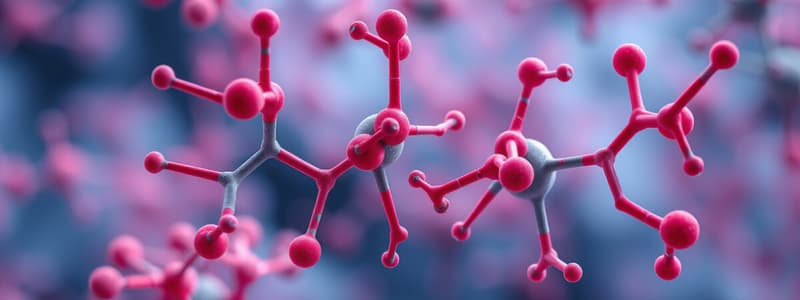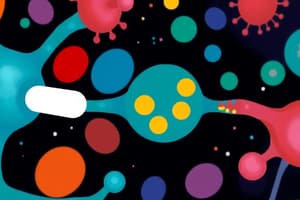Podcast
Questions and Answers
What distinguishes a partial agonist from a full agonist?
What distinguishes a partial agonist from a full agonist?
- Partial agonists do not bind to the same receptor sites as full agonists.
- Partial agonists only block receptor activity.
- Partial agonists evoke a response that is less than maximal. (correct)
- Partial agonists produce a maximal response.
How do partial antagonists affect the response of full agonists?
How do partial antagonists affect the response of full agonists?
- They can only act independently of full agonists.
- They have no effect on full agonists.
- They enhance the response of full agonists.
- They diminish the response of full agonists when administered prior. (correct)
What is the effect of inverse agonists on constitutively active receptors?
What is the effect of inverse agonists on constitutively active receptors?
- They enhance the activity of these receptors.
- They inactivate these receptors, preventing basal activity. (correct)
- They only bind to receptors in the presence of an agonist.
- They maintain the receptors in an active state.
What happens when both a partial agonist and a full agonist bind to the same receptor site?
What happens when both a partial agonist and a full agonist bind to the same receptor site?
What is desensitization in receptor regulation?
What is desensitization in receptor regulation?
Which statement accurately describes competitive antagonism?
Which statement accurately describes competitive antagonism?
How does allosteric modulation affect receptor activity?
How does allosteric modulation affect receptor activity?
Which of the following best describes non-competitive antagonism?
Which of the following best describes non-competitive antagonism?
What type of antagonist binds irreversibly or pseudo-irreversibly to the same site as the agonist?
What type of antagonist binds irreversibly or pseudo-irreversibly to the same site as the agonist?
Which mechanism leads to a rightward shift in the dose-response curve without affecting the agonist's maximal response?
Which mechanism leads to a rightward shift in the dose-response curve without affecting the agonist's maximal response?
What is the primary characteristic of a physiological antagonist?
What is the primary characteristic of a physiological antagonist?
How does an allosteric antagonist affect the response of an agonist?
How does an allosteric antagonist affect the response of an agonist?
What is the main effect of a competitive antagonist on agonist concentration-response relationships?
What is the main effect of a competitive antagonist on agonist concentration-response relationships?
Which of the following describes a situation of physiologic antagonism?
Which of the following describes a situation of physiologic antagonism?
In receptor antagonism, what does the term 'spare receptors' refer to?
In receptor antagonism, what does the term 'spare receptors' refer to?
What outcome is expected when allosteric modulation of a receptor occurs?
What outcome is expected when allosteric modulation of a receptor occurs?
What characteristic defines a competitive antagonist?
What characteristic defines a competitive antagonist?
How does binding of a competitive antagonist affect the response curve of an agonist?
How does binding of a competitive antagonist affect the response curve of an agonist?
Which type of antagonist binds to a different site than the agonist on the receptor?
Which type of antagonist binds to a different site than the agonist on the receptor?
In physiological antagonism, how does the antagonist exert its effect?
In physiological antagonism, how does the antagonist exert its effect?
What is the primary nature of binding for a competitive antagonist?
What is the primary nature of binding for a competitive antagonist?
Which type of antagonist involves binding that cannot be dislodged by an agonist?
Which type of antagonist involves binding that cannot be dislodged by an agonist?
How is the term 'spare receptors' defined in relation to receptor response?
How is the term 'spare receptors' defined in relation to receptor response?
What characterizes an antagonist with allosteric modulation?
What characterizes an antagonist with allosteric modulation?
Flashcards are hidden until you start studying
Study Notes
Mechanisms of Receptor Antagonism
- Antagonists can bind irreversibly or pseudo-irreversibly to the same site as agonists, shifting the dose-response curve to the right and reducing the maximum response.
- Allosteric effects occur when a ligand binds to a different site on the receptor, either inhibiting or potentiating the response, with effects saturating as the allosteric site fills.
- Physiologic antagonism results from the alteration of an agonist’s effect due to the action of another drug acting on a different receptor system, not directly affecting the agonist-receptor interaction.
- Example of physiological antagonism: Norepinephrine raises heart rate via β1 receptors, while acetylcholine reduces it through muscarinic receptors.
Competitive Antagonism
- Competitive antagonists bind reversibly to the receptor, allowing blockade to be overcome by increased agonist concentration.
- Spare receptors can influence this process, as they remain functional even without being bound.
- The agonist's maximal efficacy remains unchanged, although the response curve shifts to the right, parallel to the original curve.
Partial Agonists/Antagonists
- Partial agonists elicit a lesser response than full agonists, exhibiting competitive binding which decreases the efficacy of full agonist responses when administered together.
- Partial agonists can inhibit full agonist effects due to competition at the same receptor site.
Inverse Agonists
- Inverse agonists reduce the activity of constitutively active receptors, pushing them into an inactive state and eliciting a response opposite to that of an agonist.
- Contrary to prior beliefs, some receptors can remain active even without an agonist.
Receptor Regulation
- Receptor sensitivity changes can lead to desensitization, which reduces response to a drug over time.
- Exposure to the drug may activate spare receptors, which are capable of contributing to maximum responses without necessarily binding agonists directly.
Antagonist Characteristics
- Antagonists possess affinity for receptors but lack intrinsic activity.
- Competitive antagonists can be displaced by agonists, differentiating them from non-competitive antagonists.
- Understanding the binding nature (reversible vs irreversibly, allosteric vs orthosteric) is crucial in characterizing antagonism.
Studying That Suits You
Use AI to generate personalized quizzes and flashcards to suit your learning preferences.





